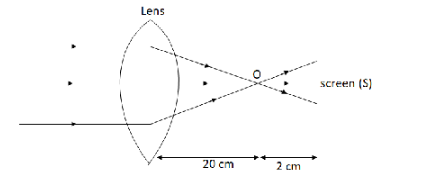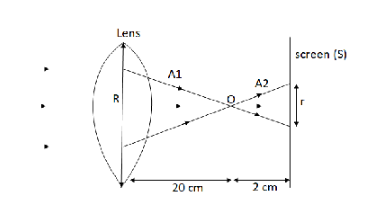
Sunlight of intensity \[1.3\,{\text{kW}}{{\text{m}}^{{\text{ - 2}}}}\] is incident normally on a thin convex lens of focal length \[20\,{\text{cm}}\]. Ignore the energy loss of light due to the lens and assume that the lens aperture size is much smaller than its focal length. The average intensity of light, in \[{\text{kW}}{{\text{m}}^{{\text{ - 2}}}}\], at a distance \[22\,{\text{cm}}\] from the lens on the other side is _________.
Answer
536.1k+ views
Hint: This is a question of ray optics, so first draw a ray diagram with the given information and check where the rays after emerging from the lens would meet. In this question we will also have to use the properties of similar triangles and use the formula for intensity to find the required answer.
Complete step by step solution:
Given, intensity of sunlight, \[I = 1.3\,{\text{kW}}{{\text{m}}^{{\text{ - 2}}}}\]
Focal length of convex lens, \[f = 20\,{\text{cm}}\]
Distance at which the average intensity has to be found from the other side of the lens, \[d = 22\,{\text{cm}}\]
We draw the ray diagram with the given conditions,

We know, rays from infinite distance or parallel to the optical axis fall on a converging lens, the emerging rays intersect at the focal point on the other side of the lens.
Here, the focal point on the other side is \[{\text{O}}\].
The distance of the screen from the other side is \[d = 22\,{\text{cm}}\] so distance of the screen from the focal point \[{\text{O}}\] will be \[d' = 2\,{\text{cm}}\].
Let \[R\] be the radius of the lens and \[r\] be the radius of the spot formed on the screen.
Now, let us redraw the figure

\[{\text{A1}}\] is the triangle formed on the left side of the focal point and \[{\text{A2}}\] is the triangle formed on the right side of focal length.
We can observe that the triangles \[{\text{A1}}\] and \[{\text{A2}}\] are similar triangles as, all their corresponding angles are congruent. We have one more property of similar triangle which says, their corresponding sides are proportional that is we can write for triangles \[{\text{A1}}\] and
\[{\text{A2}}\] ,
\[\dfrac{R}{r} = \dfrac{d}{{d'}}\]
Putting the values of \[d\] and \[d'\], we get
\[\dfrac{R}{r} = \dfrac{{20}}{2}\]
\[ \Rightarrow \dfrac{R}{r} = 10\] (i)
Intensity can be defined as energy per unit area, that is
\[I = \dfrac{{Energy}}{{area}}\]
When the rays on sunlight incident on the lens, its intensity will be
\[I = \dfrac{E}{A}\]
where \[E\] is the energy of sunlight and \[A\] is area of triangle \[{\text{A1}}\], which is \[A = \pi
{R^2}\].
Putting this value in above equation we get,
\[I = \dfrac{E}{{\pi {R^2}}}\] (ii)
The intensity on the screen will be (using the fact that there is no loss in energy so energy will be the same)
\[I' = \dfrac{E}{{A'}}\]
where \[A'\] is the area of triangle \[{\text{A2}}\], which is \[A' = \pi {r^2}\]. Putting this value in above equation we get,
\[I' = \dfrac{E}{{\pi {r^2}}}\] (iii)
Dividing equation (iii) by (ii), we get
\[\dfrac{{I'}}{I} = \dfrac{E}{{\pi {r^2}}} \times \dfrac{{\pi {R^2}}}{E}\]
\[ \Rightarrow I' = I\dfrac{{{R^2}}}{{{r^2}}} = I{\left( {\dfrac{R}{r}} \right)^2}\]
Putting the values of \[I\] and \[\dfrac{R}{r}\], we get
\[I' = 1.3{\left( {10} \right)^2}\]
\[ \Rightarrow I' = 130\,{\text{kW}}{{\text{m}}^{{\text{ - 2}}}}\]
Therefore, the average intensity of light at a distance of \[22\,{\text{cm}}\] from the lens on the other side is \[130\,{\text{kW}}{{\text{m}}^{{\text{ - 2}}}}\].
Note: Whenever you have a question of ray optics, always draw a ray diagram with the information given in the question. And with the help of the diagram find the required quantity. Also remember rays from infinite distance are considered as parallel rays, this is because as the distance between the source and the lens or mirror increases, the angle between rays from a distance source approaches zero.
Complete step by step solution:
Given, intensity of sunlight, \[I = 1.3\,{\text{kW}}{{\text{m}}^{{\text{ - 2}}}}\]
Focal length of convex lens, \[f = 20\,{\text{cm}}\]
Distance at which the average intensity has to be found from the other side of the lens, \[d = 22\,{\text{cm}}\]
We draw the ray diagram with the given conditions,

We know, rays from infinite distance or parallel to the optical axis fall on a converging lens, the emerging rays intersect at the focal point on the other side of the lens.
Here, the focal point on the other side is \[{\text{O}}\].
The distance of the screen from the other side is \[d = 22\,{\text{cm}}\] so distance of the screen from the focal point \[{\text{O}}\] will be \[d' = 2\,{\text{cm}}\].
Let \[R\] be the radius of the lens and \[r\] be the radius of the spot formed on the screen.
Now, let us redraw the figure

\[{\text{A1}}\] is the triangle formed on the left side of the focal point and \[{\text{A2}}\] is the triangle formed on the right side of focal length.
We can observe that the triangles \[{\text{A1}}\] and \[{\text{A2}}\] are similar triangles as, all their corresponding angles are congruent. We have one more property of similar triangle which says, their corresponding sides are proportional that is we can write for triangles \[{\text{A1}}\] and
\[{\text{A2}}\] ,
\[\dfrac{R}{r} = \dfrac{d}{{d'}}\]
Putting the values of \[d\] and \[d'\], we get
\[\dfrac{R}{r} = \dfrac{{20}}{2}\]
\[ \Rightarrow \dfrac{R}{r} = 10\] (i)
Intensity can be defined as energy per unit area, that is
\[I = \dfrac{{Energy}}{{area}}\]
When the rays on sunlight incident on the lens, its intensity will be
\[I = \dfrac{E}{A}\]
where \[E\] is the energy of sunlight and \[A\] is area of triangle \[{\text{A1}}\], which is \[A = \pi
{R^2}\].
Putting this value in above equation we get,
\[I = \dfrac{E}{{\pi {R^2}}}\] (ii)
The intensity on the screen will be (using the fact that there is no loss in energy so energy will be the same)
\[I' = \dfrac{E}{{A'}}\]
where \[A'\] is the area of triangle \[{\text{A2}}\], which is \[A' = \pi {r^2}\]. Putting this value in above equation we get,
\[I' = \dfrac{E}{{\pi {r^2}}}\] (iii)
Dividing equation (iii) by (ii), we get
\[\dfrac{{I'}}{I} = \dfrac{E}{{\pi {r^2}}} \times \dfrac{{\pi {R^2}}}{E}\]
\[ \Rightarrow I' = I\dfrac{{{R^2}}}{{{r^2}}} = I{\left( {\dfrac{R}{r}} \right)^2}\]
Putting the values of \[I\] and \[\dfrac{R}{r}\], we get
\[I' = 1.3{\left( {10} \right)^2}\]
\[ \Rightarrow I' = 130\,{\text{kW}}{{\text{m}}^{{\text{ - 2}}}}\]
Therefore, the average intensity of light at a distance of \[22\,{\text{cm}}\] from the lens on the other side is \[130\,{\text{kW}}{{\text{m}}^{{\text{ - 2}}}}\].
Note: Whenever you have a question of ray optics, always draw a ray diagram with the information given in the question. And with the help of the diagram find the required quantity. Also remember rays from infinite distance are considered as parallel rays, this is because as the distance between the source and the lens or mirror increases, the angle between rays from a distance source approaches zero.
Recently Updated Pages
Who is the Indian to beat the computers in Mathematical Wizardry?

Where is Himalayan Mountaineering Institute Located?

Which Country is Called "The Land of Festivals"?

Who is the Tennis Player Known as 'King of Clay'?

Who Wrote James Bond? Novel vs. Video Game Facts

India's Latest UNESCO World Heritage City?

Trending doubts
Define electric capacity Derive an expression for the class 11 physics CBSE

1 Quintal is equal to a 110 kg b 10 kg c 100kg d 1000 class 11 physics CBSE

Draw a diagram of a plant cell and label at least eight class 11 biology CBSE

What is the gut in the human body class 11 biology CBSE

10 examples of diffusion in everyday life

The excretory organs of Mollusca are a Metanephridia class 11 biology CBSE




